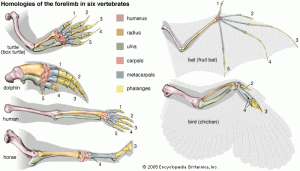Comparative Anatomy
Homologous structures
| Vertebrae | Humans | Cetaceans | |
|---|---|---|---|
| Cervical | 7 | 7 | |
| Thoracid | 12 | 9 to 18 | |
| Lumbar | 5 | 2 to 29 | |
| Sacral | 5 Fused | 0 | |
| Caudal | 4 | 19 to 27 | |
| Total Vertebrae | 33 | 37 to 81 |
Limbs
Cetacean flippers have the same bones as the forelimbs of other mammals.
The humerus, radius, ulna, carpals, metacarpals and phalanges are all present. However, in cetaceans the radius and ulna (forearm) and humerus (upper arm) are fused. Thus, they don’t have elbows.
Cetaceans have fewer bones than humans, mainly because they don’t have legs or feet. Including the individual bones that make up the skull, our sperm whale has 184 bones. The right whale has 177. Adult humans have 206.
Brains
Similarities:
- Brains are much larger than would be predicted based on body size.
- The cerebral cortex, especially in toothed whales, is highly convoluted (lots of “hills and valleys”).
- Both have a special type of brain cell (Von Economo neurons) in regions of the brain that are involved in humans in social and emotional cognition, awareness, and intuition.
Differences:
- The cetacean cerebral cortex appears to be organized differently from humans and most other mammals.
- Whales have a very small hippocampus, which is important in human memory and spatial navigation.
- The parts of the brain that are associated with the sense of smell are extremely small in mysticetes and absent in odontocetes.
- The parts of the brain that are associated with the sense of hearing are very highly developed in cetaceans.
- Cetaceans appear to keep one hemisphere (side) of their brain in a state of “alertness” when they sleep.
Acoustic vs. visual sensory perception
Many cetaceans hunt and navigate where little to no light is present. They must use sound, which travels approximately 4 times faster through water than it does through air, to find food and locate natural features in the ocean. This process, called echolocation, enables them to use sound to create an image in their brains of what those sounds waves hit. These sound waves also contain information about the size and distance of the animals or objects.
Whales, dolphins and porpoises have eyes adapted to see well in dim light, but only see in shades of gray. They see shapes clearly, recognize patterns on the sides of other cetaceans and can see when others in their pod have turned.
Size variation
Largest is blue whale (85-95 feet, 26-29 meters), smallest is vaquita (5 feet, 1.5 meters)



